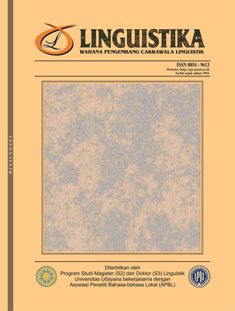PEMBENTUKAN VERBA ERGATIF DALAM BAHASA HOKKIEN: KAJIAN MORFOSINTAKSIS
Abstract
This article is discussing about the formation of ergative verb in Hokkien. A language can be called as ergative if the patient (P) of the transitive verb is treated equally or conferential with the subject (S) in the intransitive clause and is different from the agent (A) of the transitive verb. Ergative verb treats P equally with S. It is usually no indication for both. Accusative sentence is a sentence which has a system where A is equal with S and is different with P. However, active sentence is a type of sentence which shows a group of S which are acting the same with P and a group of S which are acting the same with A in a language.
In Hokkien, most verbs can be used intransitively, but usually this does not change the subject’s role. For example, “? c?ak m?en pau” (He eats bread) (transitive) and “? c?ak” (He eats) (intransitive), where the only difference is that the latter does not determine what is eaten. By contrast, with ergative verbs, the subject’s role changes; such as “Jack ph?? phua pua” (Jack broke the plate) (transitive) dan “pua phua” (the broken plate) (intransitive).













